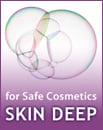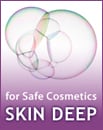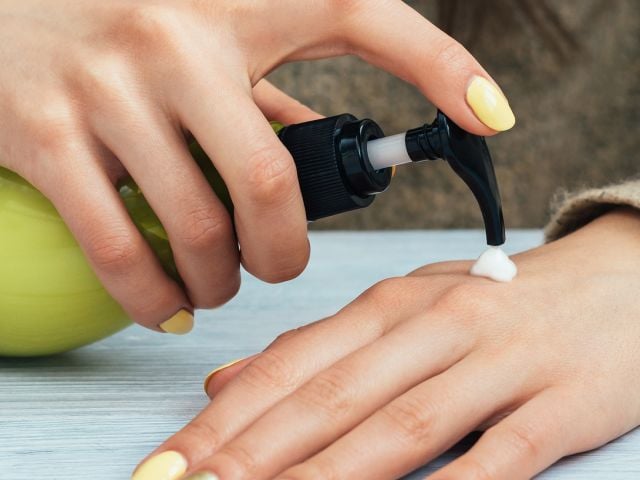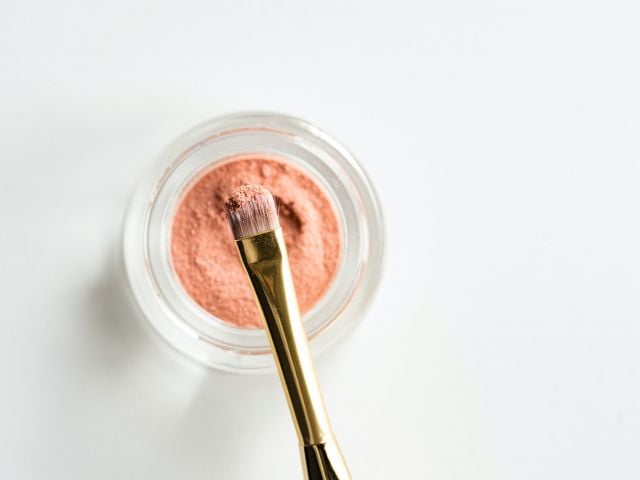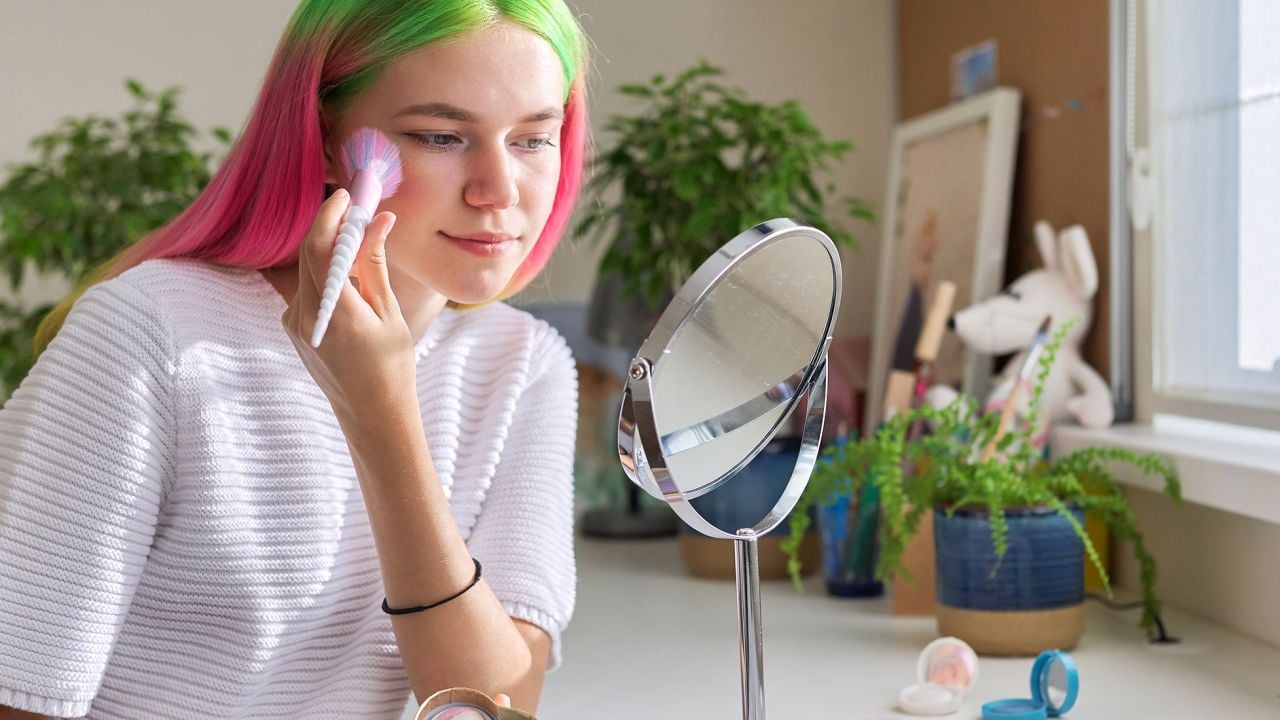
 The 20 teens we tested had an average of 13 hormone-altering cosmetics chemicals in their bodies.
The 20 teens we tested had an average of 13 hormone-altering cosmetics chemicals in their bodies.Laboratory tests reveal adolescent girls across America are contaminated with chemicals commonly used in cosmetics and body care products. Environmental Working Group (EWG) detected 16 chemicals from 4 chemical families - phthalates, triclosan, parabens, and musks - in blood and urine samples from 20 teen girls aged 14-19. Studies link these chemicals to potential health effects including cancer and hormone disruption. These tests feature first-ever exposure data for parabens in teens, and indicate that young women are widely exposed to this common class of cosmetic preservatives, with 2 parabens, methylparaben and propylparaben, detected in every single girl tested.
 In Alex (Washington DC): 12 hormone-altering cosmetics chemicals. "It's frightening to learn about the many different kinds of toxic chemicals that can be found in my body. At the same time I would much rather be knowledgeable about my body's chemical makeup than uninformed; in this case, ignorance is NOT bliss."
In Alex (Washington DC): 12 hormone-altering cosmetics chemicals. "It's frightening to learn about the many different kinds of toxic chemicals that can be found in my body. At the same time I would much rather be knowledgeable about my body's chemical makeup than uninformed; in this case, ignorance is NOT bliss."This work represents the first focused look at teen exposures to chemicals of concern in cosmetics, exposures that occur during a period of accelerated development. Adolescence encompasses maturation of the reproductive, immune, blood, and adrenal hormone systems, rapid bone growth associated with the adolescent "growth spurt," shifts in metabolism, and key changes to brain structure and function. Alterations in an array of sex hormones, present in the body at levels as low as one part per billion (ppb), or even one part per trillion (ppt), guide this transformation to adulthood. Emerging research suggests that teens may be particularly sensitive to exposures to trace levels of hormone-disrupting chemicals like the ones targeted in this study, given the cascade of closely interrelated hormonal signals orchestrating the transformation from childhood to adulthood.
Study teens use more personal care products daily than an average adult woman

Source: EWG product use surveys.
During this window of vulnerability to toxic assault, adolescent girls typically experiment with an increasing number and variety of body care products. Teen study participants used an average of nearly 17 personal care products each day, while the average adult woman uses just 12 products daily. Thus, teens may unknowingly expose themselves to higher levels of cosmetic ingredients linked to potential health effects at a time when their bodies are more susceptible to chemical damage. Cosmetics and other personal care products are an alarming example of government and industry failures to protect public health. Federal health statutes do not require companies to test products or ingredients for safety before they are sold. As a result, nearly all personal care products contain ingredients that have not been assessed for safety by any accountable agency, and that are not required to meet standards of safety. To protect the health of teens and all Americans, we recommend action:
- The federal government must set comprehensive safety standards for cosmetics and other personal care products.
- Teens should make healthy choices for themselves by reducing the number of products they use, and by using our Shopper’s Guide to Safe Cosmetics to select safer products.
- Companies must reformulate products to protect consumers from exposure to potentially toxic chemicals, untested ingredients, and noxious impurities.
Detailed findings
 In Rizza (Manteca, CA): 15 hormone-altering cosmetics chemicals
In Rizza (Manteca, CA): 15 hormone-altering cosmetics chemicals
An Environmental Working Group (EWG) study revealed the presence of 16 chemicals from 4 chemical families in the bodies of 20 American girls aged 14 to 19. Chemicals from these families, phthalates, triclosan, musks, and parabens, are all commonly used in cosmetics and body care products, and are capable of disrupting the hormone system according to laboratory tests (e.g., Gray 1986; Schreurs 2004; Gomez 2005; Veldhoen 2006). This work represents the first focused look at teen exposures to chemicals of concern in cosmetics, and in particular provides the first biomonitoring data available on levels of musks and parabens in teens. Teen use of body care products is suspected to be far higher than adult use. The young women participating in our study, recruited from locations across the U.S. and representing diverse ethnic and cultural backgrounds, used an average of nearly 17 personal care products each day, and were exposed to an estimated 174 unique cosmetic ingredients. In contrast, EWG's survey results have indicated that the average adult woman uses just 12 products with 168 unique chemicals each day (EWG 2004).
 In Erin (Ross, CA): 12 hormone-altering cosmetics chemicals. "I am living proof that one's health reflects one's lifestyle choices. Making healthier and safer choices, living a green life from day one, has significantly reduced the burden on my body."
In Erin (Ross, CA): 12 hormone-altering cosmetics chemicals. "I am living proof that one's health reflects one's lifestyle choices. Making healthier and safer choices, living a green life from day one, has significantly reduced the burden on my body."
Emerging research suggests that teens may be particularly sensitive to exposures to hormone-disrupting chemicals, given the complex hormonal signals that guide the rapid growth and development of the reproductive system, the brain, and the bone, blood, and immune systems during adolescence (Golub 2000). Chemicals within each of the 4 chemical families tested have also been linked to cancer in laboratory studies (e.g., CERHR 2000; Apostolidis 2002; Darbre 2002, 2003; ACGIH 2004; EWG 2008), and a variety of other toxicities as well (e.g., CERHR 2000; ACGIH 2004; Luckenbach 2005; EWG 2008). Chronic, low-level exposures to a mixture of these and hundreds of other untested, potentially harmful industrial chemicals may contribute to falling levels of fertility, noted especially for American women under 25 (Barrett 2006), as well as increasing rates of breast and prostate cancer (SEER 2006), diabetes and obesity (AHA 2007), and many other chronic diseases. Teen study participants' bodies contained a broad array of chemicals commonly used in cosmetics and personal care products:
- We tested blood and urine samples for a total of 25 chemicals, and detected 16 of them (64%) in our teen participants. Each young woman had between 10 and 15 chemicals in her body. 9 of these chemicals were found in every single teen tested.
- These first-ever exposure data for parabens in teens indicate that young women are widely exposed to this common class of cosmetic preservatives. All 20 participants were contaminated with 2 parabens, methylparaben and propylparaben; 2 young women were contaminated with all 6 parabens examined.
- Contamination of our group study participants with the antibacterial agent triclosan was more widespread than would be suggested by CDC data. All 20 of our teen participants had measurable levels of triclosan in their bodies, while just 78% of the 263 CDC-tested teen girls aged 14-19 were similarly contaminated (CDC 2005).
- The levels of exposure varied dramatically from participant to participant. Young women highly exposed to triclosan, methylparaben, or propylparaben had levels of these chemicals over a thousand times the levels of young women with low exposures to these chemicals.
 In Emma (Boston area): 14 hormone-altering cosmetics chemicals
In Emma (Boston area): 14 hormone-altering cosmetics chemicals
Comparisons between participants' body levels of these cosmetic chemicals and the body care products they use, on a daily basis and in total, revealed no significant links between measured exposures and the presence of individual cosmetic ingredients in their products. In addition, higher levels of musks and phthalates, and in particular the metabolite of diethyl phthalate, a common component of fragrance, were not associated with use of a greater number of personal care products containing fragrance. This lack of correlation between reported use of cosmetics chemicals and measured exposures in the body is not surprising, given widespread use of these chemicals in a variety of non-cosmetic everyday products, as well as data gaps concerning both the amounts of chemicals within each body care product, and the levels of exposure that may be expected with typical use of different products.
Test results from 20 teen girls find 16 chemicals from 4 chemical families commonly used in cosmetics and body care products (results for individual chemicals below)
Phthalates - tested for 7, found 7 Ingredients in nail polish and other cosmetics, especially those containing “fragrance,” as well as plastic containers. Some linked to birth defects in the male reproductive system of lab animals. Detected in: 20 of 20 teen girls tested
Typical level: 300 ppm creatinine in urine
Range: 102 – 1050 ppm creatinine
U.S. level for typical teen girl (CDC): 308 ppm creatinine
Triclosan - tested for 1, found 1 Preservative in products like liquid hand soap and toothpaste. Forms cancer-causing chemicals in surface waters and water treatment plants; raises concerns about potential impacts to thyroid gland and possible development of antibiotic-resistant bacteria.
Detected in: 20 of 20 teen girls tested
Typical level: 8.58 ppm creatinine in urine
Range: 0.430 – 350 ppm creatinine
U.S. level for typical teen girl (CDC): 10.2 ppm creatinine
Nitro- and polycyclic musks - tested for 11, found 2 Artificial fragrances in soap, shampoo, deodorant, and cosmetics. Linked to hormone disruption and cancer in lab animals; some build up in the food chain and in people.
Detected in: 12 of 17 teen girls tested
Typical level: 0.394 ppb in serum
Range: not detected – 2.81 ppb
Parabens - tested for 6, found 6 Preservatives in cosmetics. Linked to hormone disruption and cancer in laboratory studies.
Detected in: 20 of 20 teen girls tested
Typical level: 157 ppm creatinine in urine
Range: 8.39 – 3821 ppm creatinine
Test results from 20 teen girls find 16 chemicals from 4 chemical families commonly used in cosmetics and body care products
| Chemical class and subclass | levels of chemicals in blood or urine from 20 teen girls | number of urine or blood samples with detections | ||
| average | minimum | maximum | ||
| Phthalates (ppm creatinine in urine, measured as metabolites) | ||||
| Monomethyl phthalate (DMP metabolite) | 4.17 | Not detected | 42.1 | 13 of 20 |
| Monoethyl phthalate (DEP metabolite) | 74.6 | 15.0 | 615 | 20 of 20 |
| Monobutyl phthalate (DBP metabolite) | 48.4 | 14.4 | 109 | 20 of 20 |
| Monobenzyl phthalate (BBzP metabolite) | 15.4 | 5.19 | 353 | 20 of 20 |
| Mono-(2-ethylhexyl) phthalate (DEHP metabolite) | 5.9 | 1.45 | 46.9 | 20 of 20 |
| Mono-(2-ethyl-5-hydroxyhexyl) phthalate (DEHP metabolite) | 39.9 | 5.64 | 389 | 20 of 20 |
| Mono-(2-ethyl-5-oxohexyl) phthalate (DEHP metabolite) | 31.9 | 5.98 | 306 | 20 of 20 |
| Triclosan (ppm creatinine in urine) | ||||
| Triclosan | 8.58 | 0.430 | 350 | 20 of 20 |
| Nitro- and polycyclic musks (ppb serum) | ||||
| Cashmeran | Not detected | Not detected | Not detected | 0 of 17 |
| Celestolide | Not detected | Not detected | Not detected | 0 of 17 |
| Galaxolide | 0.111 | Not detected | 2.81 | 10 of 17 |
| Phantolide | Not detected | Not detected | Not detected | 0 of 17 |
| Tonalide | Not detected | Not detected | Not detected | 0 of 17 |
| Traseolide | Not detected | Not detected | Not detected | 0 of 17 |
| Musk ambrette | Not detected | Not detected | Not detected | 0 of 17 |
| Musk ketone | 0.0414 | Not detected | 0.105 | 5 of 17 |
| Musk moskene | Not detected | Not detected | Not detected | 0 of 17 |
| Musk tibetene | Not detected | Not detected | Not detected | 0 of 17 |
| Musk xylene | Not detected | Not detected | Not detected | 0 of 17 |
| Parabens (ppm creatinine in urine) | ||||
| Methylparaben | 115 | 6.47 | 2918 | 20 of 20 |
| Ethylparaben | 2.47 | Not detected | 138 | 17 of 20 |
| Propylparaben | 19.6 | 0.786 | 898 | 20 of 20 |
| Isopropylparaben | 0.525 | Not detected | 20.7 | 8 of 20 |
| Butylparaben | 1.07 | Not detected | 57.9 | 17 of 20 |
| Benzylparaben | 0.0558 | Not detected | 0.608 | 4 of 20 |
Study participants
Environmental Working Group's study of hormone-altering cosmetics chemicals in teens included 20 young women from 18 cities in 8 U.S. states and the District of Columbia. Many of our study participants are pictured below.
 |
 |
 |
||||
| The 20 teens we tested had an average of 13 hormone-altering cosmetics chemicals in their bodies. |
Alex [12 hormone-altering cosmetics chemicals] Los Gatos, CA |
Rizza [15 hormone-altering cosmetics chemicals] Manteca, CA |
||||
 |
 |
 |
||||
| Sarah [13 hormone-altering cosmetics chemicals] Palm Beach Gardens, FL |
Caroline [12 hormone-altering cosmetics chemicals] Langhorne, PA |
Monica [10 hormone-altering cosmetics chemicals] University Place, WA |
||||
 |
 |
 |
||||
| Emma [14 hormone-altering cosmetics chemicals] Winchester, MA |
Jenny [14 hormone-altering cosmetics chemicals] Novato, CA |
Linda [13 hormone-altering cosmetics chemicals] San Francisco, CA |
||||
 |
 |
 |
||||
| Erin [12 hormone-altering cosmetics chemicals] Ross, CA |
Jessica [13 hormone-altering cosmetics chemicals] San Rafael, CA |
Laurie [13 hormone- altering cosmetics chemicals] North Caldwell, NJ |
||||
 |
 |
|||||
Natalie [15 hormone-altering cosmetics chemicals] San Francisco, CA |
Donalin [13 hormone-altering cosmetics chemicals] Dorchester, MA |
|||||
Teens are vulnerable
 In Linda (San Francisco, CA): 13 hormone-altering cosmetics chemicals
In Linda (San Francisco, CA): 13 hormone-altering cosmetics chemicals
A sudden flurry of interrelated hormone signals initiates the complex process of puberty in the body of an adolescent, triggering rapid development of the reproductive system. Alterations in an array of sex hormones, present in the body at levels as low as one part per billion (ppb), or even one part per trillion (ppt), guide this transformation to adulthood.
Subtle hormonal signals coordinate many other critical developmental processes occurring during human adolescence, including the adolescent "growth spurt" and associated rapid bone growth, maturation of the immune, blood, and adrenal hormone systems, shifts in metabolism, and key changes to brain structure and function. The dramatic changes of adolescence, all orchestrated via shifts in the minute levels of hormones present in healthy bodies, suggest a unique vulnerability of adolescents and pre-adolescents to the effects of exposures to low levels of hormone-active chemicals found in body care products and other everyday items.
Premature puberty – a warning sign
 In Jessica (San Rafael, CA): 13 hormone-altering cosmetics chemicals. "When I received my results from this study, I was not surprised that these chemicals are present in my blood and urine. Years ago I had switched my conventional products for organic alternatives so my results were fairly moderate, but in reality none of us should have even the smallest trace of these chemicals in our bodies. This teen body burden study is proof that something needs to be done. My results serve as permanent motivation to fight the chemical battle and win."
In Jessica (San Rafael, CA): 13 hormone-altering cosmetics chemicals. "When I received my results from this study, I was not surprised that these chemicals are present in my blood and urine. Years ago I had switched my conventional products for organic alternatives so my results were fairly moderate, but in reality none of us should have even the smallest trace of these chemicals in our bodies. This teen body burden study is proof that something needs to be done. My results serve as permanent motivation to fight the chemical battle and win."
Signs of this vulnerability are evident in girls growing up all over America. Over the last 4 decades, the age at which girls begin to develop breasts has declined by 1 to 2 years (Steingraber 2007), with black girls typically developing at an earlier age than white girls. At present, about half of all U.S. girls show signs of breast development by their 10th birthday, with 14% attaining breast buds between their 8th and 9th birthdays (Herman-Giddens 1997; Lee 2001). Early breast development, as well as the appearance of pubic hair at a young age, have become so common that in 1999 the clinical definition of early-onset or precocious puberty in the U.S. was reduced from age 8 to 7 for white girls, and from age 7 to 6 for black girls (Kaplowitz 1999). By some estimates, precocious puberty currently affects as many as 1 in 5,000 children, and is 10 times more common in girls than boys (Nebesio 2005; Partsch 2001).
Over the same 40 year time period, the age at which girls in the U.S. begin menstruating has declined by a few months, with substantial variation by ethnicity (Steingraber 2007). According to the Centers for Disease Control and Prevention (CDC), the mean age of the beginning of menstruation, or menarche, in the U.S. was 12.8 years in 1970 (Harlan 1980); nearly 40 years later, it stands at about 12.6 years for white girls, 12.1 for black girls and 12.2 for Mexican American girls (Kaplowitz 2006; Herman-Giddens 1997, 2006).
Early puberty and adult disease
 In Caroline (Philadelphia area): 12 hormone-altering cosmetics chemicals
In Caroline (Philadelphia area): 12 hormone-altering cosmetics chemicals
A girl that begins puberty at an early age is at greater risk for several adult illnesses, including breast cancer (Wang 2005; Steingraber 2007; Golub 2008) and polycystic ovary syndrome (Ibáñez 1997; Kousta 2006; Steingraber 2007; Golub 2008), a leading cause of pelvic pain and infertility. Polycystic ovary syndrome is also linked to increased risk of obesity, diabetes, and impaired glucose tolerance (Auchus 2004; Kousta 2006), and increased prevalence of risk factors associated with cardiovascular disease (Kousta 2006). In addition, girls who experience premature puberty are more likely to fail to reach normal adult height (Carel 2006; Partsch 2006). In boys, early puberty may be associated with an increased risk for testicular cancer according to some epidemiological studies (Golub 2008).
Early-maturing girls are also more prone to a variety of psychiatric or behavioral problems, including depression, eating disorders, and attempted suicide (Graber 1997; Kaltiala-Heino 2001, 2003a, 2003b), early use and abuse of drugs, alcohol, and cigarettes (Graber 1997, 2004; Kaltiala-Heino 2003b), early sexual encounters (Kaltiala-Heino 2003b), unprotected sex (Flanigan 2003), teen pregnancy (Deardorff 2005), and conduct disorders and criminal behavior (Johansson 2005; Kaltiala-Heino 2003b; Burt 2006; Celio, 2006). Early-maturing girls are also more likely to be physically and violently victimized (Haynie 2006). Women experiencing early puberties tend to have lower academic education (Johansson 2005), while late-maturing girls tend to perform better in school and are more likely to finish college (Graber 1997, 2004).
Chemical contaminants can disrupt the hormone system
 In Laurie (Newark area): 13 hormone-altering cosmetics chemicals. "The findings irk me. But I don't feel helpless because I've changed my cosmetic use dramatically since the time of the study. Volunteering to participate in the study was my first response to doubting personal care products. A slow transition to more natural (made of ingredients I recognized) and organic products followed. Now I even buy mostly bio-degradable."
In Laurie (Newark area): 13 hormone-altering cosmetics chemicals. "The findings irk me. But I don't feel helpless because I've changed my cosmetic use dramatically since the time of the study. Volunteering to participate in the study was my first response to doubting personal care products. A slow transition to more natural (made of ingredients I recognized) and organic products followed. Now I even buy mostly bio-degradable."
While improved nutrition and increased incidence of obesity may play a role in the falling age of puberty, scientists and medical professionals increasingly identify exposures to hormone-disrupting chemicals as a potentially critical factor in unnaturally accelerating this critical period of development. Few epidemiological studies probe the association between exposures to trace levels of widely used hormone-disrupting chemicals and the timing of puberty. However, preliminary research on people suggests that exposures to phthalates (Colon 2000), the pesticide DDT and its metabolite DDE (Krstevska-Konstantinova 2001; Vasiliu 2004), and polybrominated biphenyls (PBBs; Blanck 2000), may be linked to early puberty in girls. In contrast, exposures to the pesticide endosulfan (Saiyed 2003), polychlorinated biphenyls (PCBs; Den Hond 2002), and lead (Hauser 2008) may be linked to delayed puberty in boys. The hormone-disrupting properties of these chemicals have been corroborated in numerous animal studies (e.g., ATSDR 1995, 1997, 2000, 2002).
Animal studies also indicate that exposures during puberty to hormone-disrupting contaminants may trigger unique and lasting adverse health effects unlike those seen for exposures during adulthood. For example, immature and pubertal rats appear to be more sensitive than adults to testicular toxicity induced by exposure to phthalates, perhaps due to differences in the absorption or metabolism of these compounds (Gray 1986; Sjoberg 1986; Dostal 1988). Immature male rats are also more sensitive than adults to the pesticide 1,2-dibromo-3-chloropropane (Lui 1987). This pesticide was banned after reports of infertility in occupationally exposed men. In parallel, immature rats may be more susceptible than adult rats to ovarian toxicity produced by the industrial chemical 4-vinylcyclohexene diepoxide (Flaws 1994).
Animal studies on breast cancer also indicate that the period around puberty, in which mammary glands undergo critical types of development, may be a period of special vulnerability to toxic chemicals that can provoke alterations in development that predispose the breast to cancer (Fenton 2006). Animals exposed to the extremely potent hormone disruptor dioxin experienced inhibited mammary gland development, the effects of which persisted into adulthood (Brown 1998; Lewis 2001; Fenton 2002). A study of 200 Belgian adolescents exposed to dioxin and other chemicals via pollution demonstrated a significant delay in breast development in girls associated with a doubling of serum dioxin concentrations (Den Hond 2002).
 In Jenny (Novato, CA): 14 hormone-altering cosmetics chemicals. "After my results came back, I was shocked to see that almost none of my toxicity levels were low. I've always considered myself to be very conscious about what gets into my body, and it made me realize that I cannot approach this campaign on a passive level, thinking that if I use safe washing detergent and eat foods without pesticides I'll be fine. Instead, I now realize that I need to focus my energy into both individual and global efforts against harmful chemicals."
In Jenny (Novato, CA): 14 hormone-altering cosmetics chemicals. "After my results came back, I was shocked to see that almost none of my toxicity levels were low. I've always considered myself to be very conscious about what gets into my body, and it made me realize that I cannot approach this campaign on a passive level, thinking that if I use safe washing detergent and eat foods without pesticides I'll be fine. Instead, I now realize that I need to focus my energy into both individual and global efforts against harmful chemicals."
Researchers at the University of California at Davis have performed a thorough examination of the effects of hormone disruption during adolescence by exposing female rhesus monkeys to known estrogenic agents methoxychlor and diethylstilbestrol (DES) during puberty (Golub 2003, 2004). DES in particular was found to have a dramatic effect on development, triggering increased incidence of ovarian cysts, suppression of menses, premature emergence of some secondary sex characteristics and delayed emergence of others, inhibition of the adolescent growth spurt, reduced bone mass and length, and alterations to a number of blood and immune system parameters. Disruption in these systems could alter adult risk for reproductive system dysfunction, as well as osteoporosis, heart disease, and autoimmune disease.
Deficient public health policies leave teens at risk
Despite this evidence, little concerted effort has been made to evaluate the relative sensitivity to toxic assault of the breast, the male and female reproductive systems, and the brain, blood, bone, and immune systems during adolescence, as compared to adulthood. Though a recent review by government scientists of "critical windows" of vulnerability to the effects of toxic chemicals reveals an urgent need for study of exposures during puberty (Selevan 2000), standardized animal tests that probe for many of these effects have yet to be developed.
 In Monica (Seattle area): 10 hormone-altering cosmetics chemicals. "I was still a little surprised that I still tested positive for many of the tested chemicals. In general I feel that most teenagers are not aware of the chemicals that are entering their bodies from cosmetics."
In Monica (Seattle area): 10 hormone-altering cosmetics chemicals. "I was still a little surprised that I still tested positive for many of the tested chemicals. In general I feel that most teenagers are not aware of the chemicals that are entering their bodies from cosmetics."
Also lacking are public health policies that recognize this unique adolescent sensitivity to chemical exposures, a sensitivity alarmingly highlighted by the dangerous side effects adolescents can experience when treated with specific antidepressants and drugs tested only on adults (Pryor 2000; FDA 2007). For example, EPA required nearly a decade of review to update its cancer risk guidelines in 2003, finally conceding the importance of general childhood exposures to toxic chemicals (EPA 2005). The new policy targets only cancer, leaving EPA with no formal policy regarding childrens' and teens' vulnerability to chemicals that damage the immune system, the brain, the hormone system, or a host of other potential targets, despite evidence that these populations face higher risks for harm.
The U.S. Food and Drug Administration (FDA), the government agency responsible for regulating both pharmaceuticals and personal care products, has recently instituted policies designed to improve pediatric drug research and treatment. In contrast, FDA provides no safety standards that protect children or adolescents from potentially harmful ingredients in body care products. Despite well-known examples of the premature appearance of pubic hair or breast buds on girls and boys following use of body care products containing high levels of estrogen, placenta, tea tree essential oil, or lavender essential oil (Zimmerman 1995; Tiwary 1998; Felner 2000; Golub 2000; Henley 2007), FDA has no authority to require premarket testing of personal care product ingredients for safety. This appalling lack of responsibility leaves all American teens at risk.
Why aren't all products safe?
 In Sarah (Miami area): 13 hormone-altering cosmetics chemicals
In Sarah (Miami area): 13 hormone-altering cosmetics chemicals
Adolescence is a time of experimentation and the first steps toward independence. Girls entering adolescence have often begun a lifelong exploration of their own individual styles, which may be expressed in part through the beauty and body care products they use. Like most Americans, teens assume that personal care products readily available on store shelves do not contain ingredients or impurities known or suspected of causing lasting damage to human health.
In fact, the Food and Drug Administration (FDA) has no authority to require testing of personal care product ingredients for safety before they are sold. Instead, FDA states that the manufacturers of these products, with few exceptions, "may use essentially any raw material as a cosmetic ingredient and market the product without an approval from FDA" (FDA 1995). While the required ingredient list on body care products provides consumers, including teens, with some information, this list does not document the presence of impurities – contaminants formed when a raw material is manufactured, or when it breaks down within a product – many of which are commonly found in cosmetics. Worse, FDA does not have the power to require the recall of a harmful product – recalls are voluntary company actions, and the mere act of FDA suggesting a recall requires that the Agency have firm evidence of potential human harm.
 In Natalie (San Francisco, CA): 15 hormone-altering cosmetics chemicals. "I think the fact that this issue even exists is ridiculous. Although the results are frightening, I am honored to be a participant in this study as it is a problem that truly affects everyone."
In Natalie (San Francisco, CA): 15 hormone-altering cosmetics chemicals. "I think the fact that this issue even exists is ridiculous. Although the results are frightening, I am honored to be a participant in this study as it is a problem that truly affects everyone."
In place of government authority to ensure safety, the personal care products industry polices itself through an industry panel called the Cosmetic Ingredient Review (CIR). This industry-funded panel of scientists has reviewed just 11% of all ingredients in cosmetics, including many no longer in regular use. An EWG investigation found that the panel chooses criteria regarding sensitivity and irritation for 80% of its safety recommendations, ignoring more serious health concerns such as cancer, birth defects, and hormone disruption, and as a result finds more than 99% of ingredients reviewed safe as used. What's more, companies are not bound by the panel's restrictions or recommendations – compliance is entirely voluntary.
As it stands, it's up to individual cosmetic companies to make decisions about safety – for adults and teens alike. Some companies make body care products safe enough to eat; others make products using ingredients with documented links to birth defects in humans, or ingredients laced with cancer-causing impurities.
Companies are also free to represent their products in any way they choose - marketing claims for body care products are entirely unregulated. FDA tried establishing official definitions for terms like "natural" and "hypoallergenic," but these protections were overturned in court. As a result, manufacturers can use marketing claims "to mean anything or nothing at all" (FDA 2000). According to FDA, "Image is what the cosmetics industry sells through its products, and it's up to the consumer to believe the claims or not" (FDA 2000). While FDA has taken pains to research and account for the still-maturing decision-making abilities of teens using over-the-counter medications (FDA 2007b), they have made no attempt to protect teens from the deceptive marketing practices used in the cosmetics industry.
 In Donalin (Boston area): 13 hormone-altering cosmetics chemicals
In Donalin (Boston area): 13 hormone-altering cosmetics chemicals
Body care products provide an appalling example of the inadequacy of current chemical regulations in the U.S. The Federal Food, Drug, and Cosmetic Act, the law governing cosmetics safety, does not require companies to test products for safety before they are sold. The Toxic Substances Control Act, the law that regulates all industrial chemicals in the United States, was created over 3 decades ago, and assumes chemicals in everyday products are innocent until proven guilty. The products we and our children use each day can contain thousands of ingredients that have never been tested for safety.
We cannot continue to allow a self-regulating industry to make decisions about the health of young women and men throughout America. Health protective reform of chemical standards must include:
- Premarket testing of products and their ingredients for safety.
- Protective purity standards for ingredients.
- Attention to the effects of mixtures of chemicals on human health.
- Safety standards that acknowledge critical developmental “windows of vulnerability” to chemical exposures, including the period of adolescence.
Cosmetics chemicals of concern
Teen participants were tested for chemicals from 4 chemical families commonly used in body care products.
Phthalates
Triclosan
Musks
Parabens
Table: Cosmetics chemicals can alter the hormone system
Phthalates
What are phthalates?
The widely-used group of chemicals called phthalates (pronounced THA-lates) can interfere with hormones in the body, posing potential risks to the reproductive and thyroid systems (Duty 2003, 2004, 2005; Swan 2005; Main 2006; Hauser 2007; Huang 2007; Meeker 2007). Preliminary studies also link phthalates to diabetes risk and asthma (Bornehag 2004; Stahlhut 2007; Jaakkola 2008; Kolarik 2008). Phthalates are detected in nearly every American, from babies to adults (CDC 2005). According to a large national survey conducted by the Centers for Disease Control and Prevention (CDC), levels of phthalates in some U.S. women of childbearing age exceed the government's safe levels (Kohn 2000). Phthalates are widespread contaminants in the environment and in wildlife as well (Kolpin 2002; Rudel 2003).
How are we exposed to them?
Though not always listed on labels, phthalates are common ingredients in cosmetics and body care products. Dibutyl phthalate may be found in nail polish. Phthalates are also used to moisturize and to help chemicals absorb into the skin. The most common use of phthalates is as an ingredient in "fragrance" mixtures added to body care products. Companies are not required to reveal the ingredients making up fragrance mixtures on the labels of products. EWG product testing found phthalates in nearly three-quarters of 72 name-brand products, though none of them listed phthalates as ingredients (EWG/HCWH/WVE 2002). Phthalates also soften plastic used in a wide range of ordinary products, from food wraps and toys to building materials and medical equipment. Currently, the chemical industry produces billions of pounds of these chemicals each year. People are exposed to phthalates daily through contact with everyday products and via food, indoor air, and even house dust (CDC 2005).
What are the potential health effects?
Studies of ordinary people suggest exposures to phthalates increase the risk of reproductive system birth defects and hormonal changes in baby boys (Swan 2005; Main 2006). In adult men they are linked to reduced sperm motility and concentration, increased damage to sperm DNA, and hormonal changes (Duty 2003, 2004, 2005; Hauser 2007). Phthalate exposures are linked to obesity and insulin resistance in men (Stahlhut 2007), conditions that can lead to Type 2 diabetes. They are also linked to thyroid irregularities in both men and women (Huang 2007; Meeker 2007), and to asthma and skin allergies in children (Bornehag 2004; Jaakkola 2008; Kolarik 2008). Animal studies indicate exposure to phthalates can trigger miscarriage or cause infertility in females, and can cause birth defects in male and female offspring of animals exposed during pregnancy (e.g., Marsman 1995; Wine 1997; Ema 1998; Mylchreest 1998, 1999, 2000; Gray 1999, 2000; CERHR 2000).
Have these chemicals been regulated?
Phthalates are considered hazardous waste and are regulated as pollutants in air and water. One phthalate, DEHP, is regulated in drinking water. DEHP was allegedly removed voluntarily from children's toys over a decade ago. However, 2 recent studies detected DEHP in toys on the market today (Purvis 2005; Kay 2006). Bans on specific phthalates in children’s products were passed recently, first in California, and then nationwide. Phthalates are unregulated in food, cosmetics, and medical products in the U.S. In contrast, the European Union restricts use of some phthalates.
How can we prevent future exposures?
Because phthalates are found in many everyday products, some exposure may be unavoidable. One way to reduce exposure is to switch to phthalate-free cosmetics and body care products. Choose products that do not list "fragrance" as an ingredient, and nail polish that does not contain dibutyl phthalate. You can also choose fragrance-free detergents and cleaning products, eat less food packaged in plastic, and not microwave food in plastic containers.
Triclosan
What is triclosan?
Triclosan is an artificial antimicrobial chemical used to kill bacteria on the skin and other surfaces. Triclosan is used in a variety of cosmetics and everyday products. Recent studies suggest this chemical may disrupt thyroid function (Veldhoen 2006), and can form toxic byproducts in tap water and in the environment (Adolfsson-Erici 2002; Lindstrom 2002; Lores 2005; Fiss 2007). A scientific advisory panel to the U.S. Food and Drug Administration (FDA) determined that "antibacterial" soaps, like those containing triclosan, were no better than regular soap and water at killing germs or reducing the spread of infection (FDA 2005). The American Medical Association recommends that triclosan and other "antibacterial" products not be used in the home, as they may encourage bacterial resistance to antibiotics (Tan 2002). Despite this advice, widespread use has led to detection of triclosan in the breast milk, blood, and urine of ordinary people (Adolfsson-Erici 2002; TNO 2005; Allmyr 2006a, 2006b; Dayan 2007; Calafat 2008). CDC’s national survey indicates that triclosan contaminates the bodies of 75% of the American population (Calafat 2008).
How are we exposed to triclosan?
Triclosan is the most common active ingredient in "antibacterial" liquid hand soaps, and is also found in toothpastes, deodorants, face and body washes, and acne treatments, among others. Besides cosmetics, triclosan is found in an increasing number of everyday items, such as dishwashing detergent, kitchen tools, toys, trash bags, bedding, bathmats, socks, and footwear (EWG 2008). Triclosan also contaminates household dust (Canosa 2007).
What are the potential health effects?
Triclosan accumulates in fat and can build up in the bodies of people and animals over time (Samsøe-Petersen 2003). An animal study indicates tadpoles exposed to tiny amounts of triclosan experience disruption of the thyroid system (Veldhoen 2006). Triclosan increased the effect of thyroid hormones when it was present in water at levels below 1 part per billion. Such low levels are commonly measured in people, and in rivers and streams, due to widespread use of triclosan (Kolpin 2002; Calafat 2008). The thyroid hormone system is similar in frogs and humans, suggesting that triclosan may disrupt the human thyroid system. Thyroid hormones are critical for normal growth and development of humans as well; the developing brain of a child is particularly vulnerable to damage caused by disruption of the thyroid system. Triclosan may also disrupt other critical hormone systems. A recent lab study found the chemical to exert both estrogenic and androgenic effects on human breast cancer cells (Gee 2008). Studies of fish suggest that triclosan may have weak androgenic (Foran 2000) or anti-estrogenic effects (Matsumura 2005), while a metabolite of triclosan may have estrogenic effects (Ishibashi 2004). Other animal studies link triclosan to inhalation and liver toxicity and cancer (EWG 2008). Triclosan can react with chlorine in tap water to form chloroform, a suspected cancer-causing chemical (Fiss 2007). It can also degrade into a type of dioxin (Lores 2005), part of a group of highly toxic chemicals, and a compound called methyl triclosan that is toxic to aquatic life (Adolfsson-Erici 2002; Lindstrom 2002; Farré 2008). Triclosan may also promote antibiotic resistance in bacteria, because while repeated use kills most bacteria, this can allow resistant strains to flourish (Levy 2001; Tan 2002; Aiello 2005).
Has the chemical been regulated?
Triclosan is regulated by FDA when used in cosmetics and for medical applications, by the U.S. Environmental Protection Agency (EPA) when used as an antibacterial pesticide (in products that make "antibacterial" claims), and by the Consumer Product Safety Commission (CPSC) when used in ordinary consumer products that do not make specific "antibacterial" claims. Current regulations do not take into account concerns regarding hormone disruption or formation of toxic byproducts, nor do they fully account for the potential for multiple exposures through the broad variety of triclosan-treated everyday products.
How can we prevent future exposures?
Because triclosan is found in many everyday products, some exposure may be unavoidable. One way to reduce exposure is to switch to triclosan-free cosmetics and body care products. Avoid body care products, especially liquid hand soaps, labeled "antibacterial," and always check the list of ingredients. Triclosan will be listed as an active ingredient on the product label. If you use a skin disinfectant, use an alcohol hand rub or rinse. Avoid "antibacterial" dishwashing detergents, cleaning products, and other items – there is no evidence that these products protect your health. Triclosan is approved for use in over 140 different types of products, and most of these are not required to have ingredient labels (EWG 2008). Vague claims such as "protection against mold," "odor-fighting" or "keeps food fresher, longer," may also indicate the presence of triclosan.
Musks
What are musks?
Nitro- and polycyclic musks are artificial chemicals used for decades in "fragrance" mixtures added to everyday products. Animal studies indicate musks may disrupt the hormone (endocrine) system (Seinen 1999; Schreurs 2004), and may disturb a natural defense the body uses to protect itself from toxic chemicals (Luckenbach 2005). Laboratory studies also link some musks to cancer (Maekawa 1990; Apostolidis 2002). Widespread use of musks has led to detections in fish and in rivers and lakes (Balk 1999; Fromme 1999, 2001; Gatermann 2002; Peck 2004, 2006; Duedahl-Olesen 2005; Kannan 2005). Musks can accumulate in fat and build up in the human body, and have been detected in people’s breast milk, fat, and blood (Rimkus 1996; Liebl 2000; TNO 2004, 2005; Hutter 2005; Lignell 2008).
How are we exposed to them?
Musks are often used in cosmetics and body care products, like perfume and soap, that contain "fragrance." Musks are also used in air fresheners, detergents, fabric softeners, cleaning products, cigarettes, and as food additives. Musks can be absorbed through the skin, inhaled, and ingested; skin absorption and inhalation are important routes of exposure through cosmetics. Daily use of body care products containing "fragrance" can result in repeated, direct exposures.
What are the potential health effects?
Some musks irritate the skin, or trigger allergic reactions (Cronin 1984; Parker 1986; Hayakawa 1987, 1991; Menz 1988; Thune 1988; DeLeo 1992; Kanchan 2002). In laboratory studies, certain musks have been linked to cancer (Maekawa 1990; Apostolidis 2002), and others no longer in common use harm the nervous system (Spencer 1984; Ford 1990; Rimkus 1996, 1997). Laboratory studies indicate that some musks can disrupt the hormone system (Seinen 1999; Chou 1999; Bitsch 2002; Gomez 2005; Schreurs 2004, 2005a, 2005b). A study of nitromusks in people suggests that higher levels of some musks may be linked to reproductive problems in women (Eisenhardt 2001). A recent animal study found that low levels of nitro- and polycyclic musks interfere with the ability of structures in cell walls to keep toxic substances from entering the cell (Luckenbach 2005). By disturbing a cell’s natural ability to fend off toxic chemicals, musks could allow poisons to build up within cells and cause damage. Human cells have the same cell wall structures as those examined in this study, indicating a cause for concern.
Have these chemicals been regulated?
Growing concerns about the health effects of nitromusks led the European Union to ban the use of some of these chemicals in cosmetics and body care products. Many companies have begun to use polycyclic musks in place of nitromusks because they are believed to be less toxic (Daughton 1999; OSPAR 2004). But some studies suggest that polycyclic musks pose some of the same health risks suspected of nitromusks. A nitromusk (musk ambrette) and a polycyclic musk have been removed from the market voluntarily due to health concerns. In the United States, all musk chemicals are unregulated, and safe levels of exposure have not yet been set.
How can we prevent future exposures?
Because musks are found in many everyday products, some exposure may be unavoidable. One way to reduce exposure is to switch to fragrance-free cosmetics and body care products – choose products that do not list "fragrance" as an ingredient. Musks are added to many other products, including laundry detergents, fabric softeners, and household cleaners – choose fragrance-free versions of these products as well. Unfortunately, as there is no requirement for companies to list ingredients on these products, it can be difficult to tell which contain fragrance. Finally, avoid air fresheners, which provide a blast of artificial fragrance to cover up other odors.
Parabens
What are parabens?
In use since the 1920s, parabens are a group of artificial preservatives commonly found in many different cosmetics and body care products. Parabens are used to prevent the growth of bacteria and mold in a cosmetic product, increasing its shelf life. Laboratory studies suggest parabens can disrupt reproductive hormones (Routledge 1998; Oishi 2001, 2002a, 2002b; Byford 2002; Darbre 2002, 2003; Inui 2003; Gomez 2005; Mikula 2006; Pugazhendhi 2007). In 2006, the Centers for Disease Control (CDC) tested urine samples from a group of 100 adults and found parabens in nearly all samples (Ye 2006). Cosmetics typically contain mixtures of parabens. Of the 6 we measured, 5 are fairly common in cosmetics: methyl-, ethyl-, propyl-, isopropyl-, and butylparaben (measured in combination with isobutylparaben); benzylparaben is less common.
How are we exposed to them?
Parabens are present in a wide variety of cosmetics and body care products, including moisturizers, face and skin cleansers, shampoos, conditioners, sunscreens, deodorants and antiperspirants, shaving gels, toothpastes, makeup, and many others. They are also used as preservatives in food and beverages, and in some medications. Daily use of body care products can result in repeated, direct exposure to parabens. Parabens have also been detected in household dust (Canosa 2007).
What are the potential health effects?
Some parabens can irritate the skin or cause allergic reactions (Schamberg 1967; Nagel 1977; Soni 2001, 2002; CIR 2006). Laboratory studies indicate that parabens are estrogenic, meaning they can mimic the hormone estrogen, disrupting normal function of the hormone system (Routledge 1998; Oishi 2001, 2002a, 2002b; Byford 2002; Darbre 2002, 2003; Inui 2003; Gomez 2005; Mikula 2006; Pugazhendhi 2007). In a recent study, traces of 5 different parabens were found in the breast cancer tumors of 19 of 20 women examined (Darbre 2004); other lab studies also link parabens to cancer (Byford 2002; Darbre 2002, 2003; Pugazhendhi 2007), and to reproductive health problems as well (Oishi 2001, 2002). When personal care products containing parabens are combined with chlorinated tap water, a number of chlorinated paraben byproducts can form (Canosa 2006). These chlorinated paraben chemicals have not been assessed for safety. Some are persistent, and have been detected in samples of untreated wastewater (Canosa 2006). Parabens are also linked to ecological harm; low levels of butylparaben can kill coral, according to laboratory tests (Danovaro 2008).
Have these chemicals been regulated?
The European Union banned use of sodium methylparaben in fragrance because it can strip skin of pigment (SCCPNFP 1999, 2000). While FDA limits the levels of parabens allowed in foods and beverages, it does not regulate these chemicals in cosmetics and body care products.
How can we prevent future exposures?
Because parabens are found in many everyday products, some exposure may be unavoidable. One way to reduce exposure is to switch to paraben-free cosmetics and body care products.
Cosmetics chemicals can alter the hormone system
A survey of some of the latest science on cosmetics chemicals shows these widely used ingredients can disrupt the normal function of the hormone system.
| Hormone | Disruption caused by cosmetic chemicals | Role of hormone in the human body | Typical concentrations of hormone in serum |
| Reproductive Hormones | |||
| Estradiol (estrogen) | Phthalates: Cell studies show phthalates can replace estradiol on estrogen receptor sites (CERHR 2000). A study of female rats indicates one phthalate can reduce levels of estradiol in the body (CERHR 2000). Triclosan: Cell studies show triclosan can replace estradiol on estrogen receptor sites, and can increase the growth of estrogen-sensitive breast cancer cells (Gee 2008). A frog study indicates triclosan may have anti-estrogenic effects (Matsumura 2005), while a fish study indicates a metabolite of triclosan may have estrogenic effects (Ishibashi 2004). Musks: Cell studies show some musks produce weak estrogenic (Seinen 1999; Bitsch 2002; Gomez 2005) and anti-estrogenic effects (Schreurs 2005a, 2005b). Fish studies show certain musks produce anti-estrogenic effects (Schreurs 2004). Cell studies show metabolites of musks produce estrogenic effects (Chou 1999). Parabens: Cell studies show certain parabens produce estrogenic effects (Routledge 1998; Gomez 2005). In particular, parabens can stimulate the growth of estrogen-sensitive breast cancer cells (Byford 2002; Darbre 2002, 2003; Pugazhendhi 2007), and have been detected in 19 of 20 human breast cancer tumors examined (Darbre 2004). Studies of lab animals also demonstrate estrogenic effects (Routledge 1998; Darbre 2002, 2003; Inui 2003; Mikula 2006). |
In women, this potent form of estrogen maintains the reproductive system, guides development of feminine characteristics, and promotes health of many other non-reproductive body functions; in men, estrogens support maturation of germ cells. | women of childbearing age: 20 to 400 ppt; post-menopausal women 5 to 25 ppt; men 10 to 60 ppt |
| Follicle-stimulating hormone | Phthalates: Men highly exposed to certain phthalates are more likely to have altered body levels of follicle-stimulating hormone (Duty 2005). | Stimulates development and maturation of a follicle in a woman’s ovaries; in men, involved in sperm formation, as well as enhanced production of androgen-binding protein by the Sertoli cells of the testes. | women of childbearing age: 5 to 30 international units per liter (IU/L); post-menopausal women 50 to 100 IU/L; men 5 to 20 IU/L |
| Luteinizing hormone | Phthalates: Baby boys consuming breast milk high in some phthalates tend to have altered body levels of both luteinizing hormone and ratios of luteinizing hormone to testosterone (Main 2006). | Triggers ovulation in women; in men, stimulates production of testosterone from the Leydig cells in the testes. | women: 1.2 to 4.6 ppm; men: 1.6 to 5.5 ppm |
| Testosterone | Phthalates: Baby boys consuming breast milk high in certain phthalates tend to have altered body levels of both testosterone and ratios of luteinizing hormone to testosterone (Main 2006). Animal studies show phthalates can reduce testosterone levels in the body (Lottrup 2006). Triclosan: Cell studies show triclosan can replace testosterone on androgen receptor sites, and can inhibit the growth of androgen-sensitive breast cancer cells treated with testosterone (Gee 2008). Fish studies show changes in fin length and non-significant trends in sex ratio suggesting that triclosan may be weakly androgenic (Foran 2000). Musks: Male lab animals treated with certain parabens show reduced levels of testosterone and increased incidence of reproductive system problems (Oishi 2001, 2002a, 2002b). |
In men, responsible for development of masculine characteristics; guides anabolic processes relating to muscle mass, bone density, growth, and strength; can be converted to estradiol. | women: 0.1 to 0.8 ppb; men: 2.5 to 8 ppb |
| Androstenedione | Musks: A study of women with gynecological and endocrine dysfunction indicates women with high levels of musk ketone are more likely to have altered levels of androstenedione in their bodies (Eisenhardt 2001). | In women and men, converted metabolically to testosterone and other androgens, and to estrone. | women of childbearing age: 0.6 to 3 ppb; post-menopausal women 0.3 to 8 ppb; men 0.9 to 1.7 ppb |
| Androstanediol-glucuronide | Musks: A study of women with gynecological and endocrine dysfunction indicates women with high levels of some musks are more likely to have altered levels of androstanediol-glucuronide in their bodies (Eisenhardt 2001). | In women and men, a primary regulator of secretion of luteinizing hormone and follicle-stimulating hormone. | women: 0.56 to 3.4 ppb; men 2.7 to 7.6 ppb |
| Inhibin B | Phthalates: Men highly exposed to certain phthalates may show altered body levels of inhibin B (Duty 2005). | Inhibits production of follicle-stimulating hormone. | women of childbearing age: 45 to 286 ppt; post-menopausal women: less than 7 ppt; men 60 to 300 ppt |
| Sex-hormone binding globulin | Phthalates: Baby boys consuming breast milk high in certain phthalates typically have altered body levels of sex-hormone binding globulin (Main 2006). | A glycoprotein that binds to sex hormones, specifically testosterone and estradiol, controlling their activity in the body. | women: 1.6 to 7.0 ppt; men 0.57 to 4.2 ppt |
| Thyroid Hormones | |||
| T3 | Phthalates: Men highly exposed to certain phthalates typically show altered levels of T3 in their bodies (Meeker 2007). Triclosan: Exposure to low levels of triclosan increases the potency of T3, according to a study on tadpoles (Veldhoen 2006). The thyroid hormone system is similar in frogs and humans, suggesting that triclosan may disrupt the human thyroid system. |
Potent form of thyroid hormone that regulates metabolism and sensitivity to specific adrenal hormones, and affects protein synthesis. | 1.1 to 2.3 ppb |
| T4 | Phthalates: Pregnant women highly exposed to certain phthalates typically have altered levels of T4 in their bodies (Huang 2007). Men highly exposed to certain phthalates tend to have altered levels of T4 in their bodies (Meeker 2007). | Less active form of thyroid hormone that regulates metabolism and sensitivity to specific adrenal hormones, and affects protein synthesis. | 40 to 110 ppb |
Acknowledgments
This report was made possible by the support of The Women’s Foundation of California, Lucy R. Waletzky, M.D., and other funders.
Special thanks to each of the 20 young women who volunteered to participate in this study. The donation of your time and samples will help to further our understanding about our exposures to chemicals of concern in cosmetics and body care products. The information from this study will add to the growing body of science that shows that teens have unique exposures and vulnerabilities to toxic chemicals, and will help to drive national chemicals policy reform that protects our most vulnerable populations.
We are especially grateful to Dr. Alan Greene for thorough review of study materials and protocol, as well as for offering his time to discuss health concerns with study participants. We are also grateful to Axys Analytical Services and TNO Laboratories for sample analysis and consultations.
Thanks to EWG interns Stefanie Graeter, Marisa Evanouski, and Dan Myers, and volunteers Margaret Sidells and Joshua Mehlman, who assisted this investigation. Tracey Woodruff (University of California at San Francisco) also provided valuable comments on this report.
Finally, EWG thanks the advocacy groups who helped us recruit study participants, including Teens for Safe Cosmetics, a part of Search for the Cause, and Massachusetts Clean Water Action.
